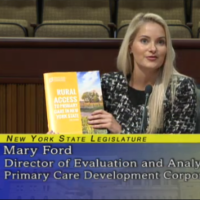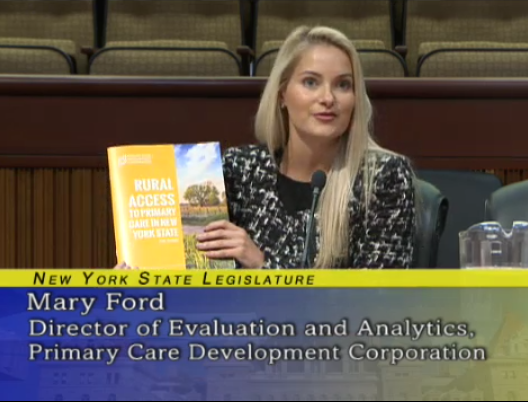PCDC Spotlights Rural Access to Primary Care at NYS Assembly Hearing


PCDC’s Mary Ford, Director of Evaluation and Analytics, testified before the New York State Assembly today, highlighting new findings about rural access to primary care.
 “We found that there are far fewer primary care providers per person in New York State’s rural and small-town communities, resulting in lower access for residents,” Ford said of PCDC’s new report, which includes specific policy recommendations.
“We found that there are far fewer primary care providers per person in New York State’s rural and small-town communities, resulting in lower access for residents,” Ford said of PCDC’s new report, which includes specific policy recommendations.
“Where urban areas have 15 primary care providers per 10,000 residents, rural areas have only 3.4,” Ford said.
Below is full testimony from the hearing on rural health care services.
Thank you for the opportunity to testify before the committee today. I am Mary Ford, the Director of Evaluation and Analytics at the Primary Care Development Corporation (PCDC). PCDC is a New York-based non-profit organization and a U.S. Treasury-certified community development financial institution dedicated to building equity and excellence in primary care. Our mission is to create healthier and more equitable communities by building, expanding, and strengthening primary care through capital investment and practice transformation as well as policy and advocacy.
Over the last 25 years, PCDC has provided capital and technical assistance to over 600 health care sites across the Empire State, including seven DSRIP (Delivery System Reform Incentive Payment) Performing Provider Systems (PPS) statewide. Thanks in part to the New York State Legislature, we have financed and enhanced health care facilities and practices in more than 92% of New York’s Senate Districts and 77% of Assembly Districts to increase and improve the delivery of primary care and other vital health services for millions of New Yorkers.
In just the last five years, PCDC provided nearly $75 million in affordable and flexible financing to expand access to primary care across New York State. We are also the administrator, in partnership with the Department of Health and Dormitory Authority of the State of the New York, of the New York State Community Health Care Revolving Capital Fund, made possible by the legislature in previous years. The fund provides affordable and flexible loans to Article 28 health centers, Article 31 mental health centers, and Article 32 substance use disorder treatment centers to finance the construction, expansion, and renovation of community health care facilities throughout New York State. We have developed a pipeline of $13 million for the $19.5 million revolving fund. To date, we have closed $3 million and working to close another $2.5 million in June 2019, for a total of $5.5 million or 29% of the $19.5 million revolving fund. We are underwriting $3.3 million and have another $11.5 million of prospects, many of which are in more rural and underserved areas of the state.
Nationally, PCDC has improved primary care access for more than 1 million patients by leveraging more than $1.1 billion to finance primary care projects. Our strategic community investments have built the capacity to provide 3.8 million medical visits annually, created or preserved more than 10,600 jobs in low-income communities, and transformed 1.8 million square feet of space into fully functioning primary care practices. Through our capacity building programs, PCDC has trained and coached more than 9,300 health workers to deliver superior patient-centered care, including at NYC Health + Hospitals, where we have provided technical assistance for ambulatory care redesign for more than 15 years. We have also assisted more than 475 primary care practices — encompassing some 2,250 providers — in New York and beyond to achieve Patient-Centered Medical Home (PCMH) recognition, improving care for more than 5 million patients nationwide.
For many years, PCDC has received a generous legislative grant from the New York State Legislature. We are extremely thankful to Chairman Gottfried and the many members of this committee for your continued support, which made possible the research I will highlight today. Without the legislative grant, PCDC would not have been able to open an Evaluation and Analytics Department, lead research into the state of primary care in New York, or conduct further research on rural health, which we hope will be useful to this committee. We are grateful for the $450,000 that the Assembly added to the FY2020 budget.
In 2018, PCDC used our legislative funding to publish a report on primary care access in New York State, titled “The State of Primary Care in New York.” The report identified that rural New York State counties have reduced primary care access, worse health outcomes, and lower socioeconomic indicators than urban regions of the state. A natural progression of these findings was this year’s report, “Rural Access to Primary Care in New York State.”
We found that there are far fewer primary care providers per person in rural and small-town communities, resulting in lower access for residents. Where urban areas have 15 primary care providers per 10,000 residents, rural areas have only 3.4. The expanse of geography that rural providers must cover adds even greater barriers to care. In addition, rates of potentially preventable emergency department visits are higher in rural areas than in metropolitan areas; these rates reveal a need for increased primary care access or higher quality and more comprehensive primary care to appropriately address residents’ needs.
Our research also indicated that rural regions have higher percentages of primary care providers accepting both Medicare and Medicaid, reflecting responsiveness of providers to lower income residents in these areas. Given the few providers serving these communities, it is essential that they accept all types of insurance, especially in the safety net.
We also interviewed primary care leaders working in rural communities of New York who shared insights and challenges affecting the provision of high-quality primary care.
First, primary care provider and workforce shortages are significant obstacles to increasing access to care. While this is the case in both rural and urban areas, rural providers tend to work longer hours, see more patients, and may have a patient panel with more complex health needs. The result is provider flight or burnout, which can leave a community without essential access to care.
Dr. John Rugge, founder of the Hudson Headwaters Health Network, has been working to address workforce shortages for decades. His organization works with universities to increase student exposure to rural primary care and with local high schools to introduce students to health careers. Research has shown that if providers are recruited from rural areas, they are more likely to return and remain in these communities following medical training. This type of community-based training has been used in other states and is also recommended in a new report published this week by the Milbank Memorial Fund.[1]
Second, New York State’s opioid crisis is exacerbated by low access to primary care and substance use treatment in more rural parts of the state. Bob Ross of St. Joseph’s Addiction Treatment and Recovery Centers, an organization on the front line of the opioid epidemic in the North Country, shared four crucial responses to the crisis: expanding organizational capacity, collaborating with community partners, reducing stigma, and increasing the availability of Naloxone.
Next, finding providers who are responsive to the needs of migrant and agricultural workers can be a significant challenge for rural areas. Mary Zelazny of Finger Lakes Community Health Center provided key insight into the Migrant Voucher Program, which enables migrant workers living too far from a health center to visit a local provider. The health center can coordinate vouchers for telehealth, interpretation services, and other financial subsidies to improve the quality of care.
Finally, and importantly, all interviewees noted challenges with maintaining financially viable practices in rural areas, much of which is rooted in public health insurance reimbursement policies. Patient populations in rural and urban areas have different distributions of insurance carriers: the former have a higher percentage of public insurance, whereas the latter have higher numbers of commercial insurers with more commercial options available. For urban providers, the higher reimbursement rates of private insurers can substantially offset the lower public insurance reimbursement rates. But in rural regions, the stability of primary care practices is more contingent upon Medicaid and Medicare reimbursement rates.
We developed key policy recommendations to attract providers to rural areas of the state and make primary care delivery more equitable. Our report contains a complete list of recommendations, four of which I will highlight today.
First, the state should redefine geographic designations for reimbursement. Given rural providers’ reliance on public insurance, inequities in reimbursement for primary care are magnified in these areas. Currently there are only two geographic designations for setting Medicaid base-rate reimbursement in New York State: Upstate and Downstate. We suggest the state create a third tier based on rural area for Medicaid base rate. Revising reimbursement policies would increase provider access including region-specific payment adjustments.
Second, because reimbursement will only go so far to stem the loss of providers, it is also essential to enact policies for recruiting and retaining a rural workforce. We must extend and strengthen tuition reimbursement and loan forgiveness programs to draw primary care providers to rural areas. Our medical schools must commit to training residents outside of acute care hospitals and partner with rural providers to create exposure to these environments, both in school and in residency.
Third, we must measure and increase spending on primary care in all communities. There is neither a state or national definition of primary care, nor a clear picture of funding allocated to primary care. Recent estimates using Medicare data indicate that primary care is responsible for a staggering 2-3% of total health care spend and only 5-7% across all payers.[2] But we cannot know for sure unless action is taken. We strongly believe the legislature can and should move to measure the primary care spend in New York State and set up a commission to determine the appropriate spending level for these services. These recommendations could then be used to increase reimbursement for these services across both public and private payers, as has already been accomplished in Rhode Island, Oregon, Delaware, and most recently Colorado, Vermont, West Virginia, and Washington State.[3]
Lastly, this body must continue to work to eliminate barriers to care in rural areas. This includes but is not limited to encouraging policies and reimbursement to expand the use of telemedicine throughout New York State, integrating behavioral health practitioners in rural primary care offices, expanding home visit models for those with limited mobility including the use of visiting primary care practitioners, and expanding funding for programs that provide transportation to medical appointments for those without vehicles.
Thank you for the opportunity to share our report today with the committee. We hope it is useful as you consider future policy options and I look forward to answering any questions you may have.
###
[1] Parento, E.W. Milbank Memorial Fund. (2019) Supporting Rural Health: Practical Solutions for State Policy Makers. Retrieved from https://www.milbank.org/wp-content/uploads/2019/05/IssueBrief_RSG_RuralHealth_final_v2.pdf.
[2] Reid, R., Damberg, C., & Friedberg, M. W. (2019). Primary Care Spending in the Fee-for-Service Medicare Population. JAMA Internal Medicine.
[3] Patient-Centered Primary Care Collaborative (2019). Primary Care Investment. Retrieved from https://www.pcpcc.org/primary-care-investment.